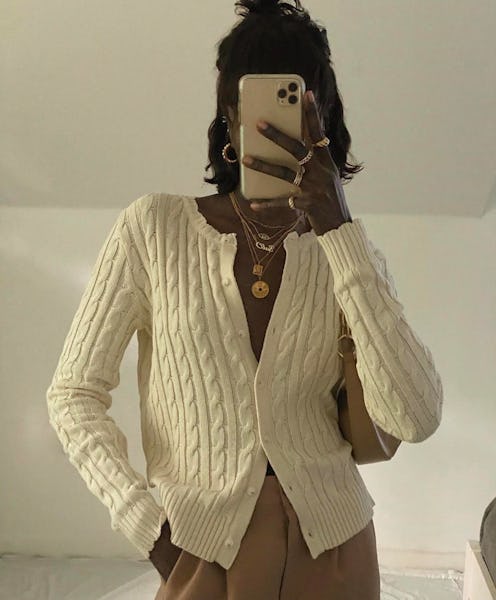With clothing choices leaning increasingly on comfort and minimalism for many consumers these days, stay-at-home-friendly trends in other categories of the fashion realm have the opportunity to thrive in the meantime. Hence, a roll-sheet of fun jewelry trends have emerged, and among the bunch, you've probably noticed your Instagram feed flooded with meticulously layered gold jewelry, the trend that is somehow just as carefree as it is polished. But, not all earrings or bracelets are created equal. and knowing how to shop for gold jewelry — the different types and price points — can help you nail the best way to style your baubles of choice.
Layering jewelry takes on multiple forms, from wearing different sized hoops simultaneously if you have multiple ear piercings, to baring four rings to a hand at a time, but necklace layering is what most has jewelry lovers hooked at the moment. "Adding a new chain to your wardrobe is an instant update to your daily look," Jennifer Fisher, Creative Director and founder of the namesake fine jewelry line tells The Zoe Report. Mixing chain textures, lengths, and thickness, both creates a well rounded look and also reduces chain tangling.
“Simple outfits are totally transformed [by layering necklaces]," Jordanna Oslac, founder of jewelry brand, Jordan Road tells The Zoe Report. "... especially during quarantine when everyone was wearing sweat outfits — adding a stack of necklaces took the sweats from basic to Zoom-ready.” It's true that piling on the gold may have been one of the most endearing trends of quarantine due to its ease and practicality, but it won't be going anywhere anytime soon, even as you step out into your new normal.
Because this beginner-friendly trend is so easy to hop on, the only thing left to consider is which variation of gold-toned jewelry on the market is best fit for your lifestyle. Being faced with terms like gold-filled and gold vermeil, it's easy to get confused, but just as easy to sort through the key differences once you really dive in. Ahead, learn how to decide between the most popular gold-toned categories, and our necklace picks to get you started on building the gold jewelry capsule your wardrobe has been waiting for.
We only include products that have been independently selected by The Zoe Report's editorial team. However, we may receive a portion of sales if you purchase a product through a link in this article.
How To Shop For Gold Jewelry: Gold Plated
Most gold jewelry you may come across during everyday shopping will be plated gold, containing a thin layer of gold over a given base metal (oftentimes brass). While this is typically the most affordable gold option (some brands do get a bit pricier than others), plated jewelry is known to tarnish quickly, and the gold plating is susceptible to rubbing off quicker than its vermeil counterparts. However, with extreme care, you can certainly stretch out its wear time. "To keep these pieces looking their best, avoid contact with water, sweat, [and] perfumes," Oslac said. Even still, plated gold is wildly popular and is so for a reason — its affordability makes it a great option for indulging in trends that may fade quickly, or for pairing with an outfit for a specific one-time event. Even better, plated jewelry’s pricing gives you the opportunity to stack up on more finds to really have fun with layering.
Shopping For Gold Jewelry: Gold Vermeil
Gold vermeil is essentially plated jewelry’s older sister. The gold layer of vermeil jewelry is thicker than that of plated jewelry (typically 2.5 microns), making for a piece that will hold its place in your rotation longer than plated gold, but will tarnish and lose its gold sheen eventually. The slightly more durable nature of gold vermeil makes it a better candidate for everyday wear, and with more brands venturing into this category to provide a variety of price points for consumers (fan-favorite brands such as Mejuri being among this selection), there are plenty of options for versatile, staple pieces to go around.
Shopping For Gold Jewelry: Gold-Filled
Gold-filled jewelry is the closest to solid gold you can get for a relatively affordable price, though the value of pure gold is unmatched. A unique technique gives gold-filled jewelry a longer lifespan than other affordable gold; a thick layer of gold is mechanically pressure-bonded to a base metal, and because the U.S. poses strict industry standards on the gold-filled title, a given piece must be composed of at least five percent of solid gold by weight. (So, contrary to its name, gold-filled jewelry is not actually "filled" with gold.) This low-maintenance alternative to solid gold is best known for its water and tarnish resistance and is the perfect candidate for gold you can take to the pool and beyond, all while on a budget.
Shopping For Gold Jewelry: Solid Gold
Similar to gold-filled jewelry, “solid gold” is often misleading in its title. Because 24 karat gold (100 percent gold) is extremely soft, making it susceptible to scratching and denting with frequent wear, most solid gold jewelry is sold as 14 karat gold (a durable combination of gold alloyed to a mixture of metals), or sometimes 18 karat, a softer combination which contains a higher percentage of pure gold. Solid gold is tarnish resistant and is highly regarded as an investment piece. "Now, more than ever, is a great time to invest in fine jewelry pieces as they never lose their value, and the value of gold is currently going up," Fisher says. As such, when shopping for fine gold, it is typically best to go for timeless, classic pieces that will stand the test of time regardless of trend cycles.
